
In the River KATSURA --Vol.95--
A big Mouth of a Brown Trout
The opening day of the River Katsura was over, making me both happy and irritated. Now I planned to fish there from morning until the fishing season started in mountainous districts. I wanted to find new spots like Asumi, where fish could be caught from the beginning of the season. In addition, the dry fly should be available there because I used only the dry fly in mountain streams in those days although I used Muddler Minnow or wet flies in the River Oshino. To be honest, I did not know the whole situations of the River Katsura. The nearer spot to Oshino we fish, like Asumi, the earlier in the season we can get some catch, so I thought.To find new spots, I went downstream as far as possible from Asumi Bridge in vain. The farther downstream I went fishing, the more miserable situation I was in. Fishing was completely impossible. The water suddenly became red or blue because of the dye works on the bank and a large amount of rubbish covered the bottom. I moved ahead to the outskirt of Fujiyoshida, where the river had a lot of water and natural colour. It was because many tributaries, whose source areas kept clear spring-water, flowed into the River Katsura.

The River Shakushinagare had a gentle slope and a lot of reeds. Big yamame trout for the river size were often caught from the early season.
I expected some catch but the embankment was so abruptly protected like a channel that I could hardly walk along the river. I was forced to make a detour to go farther downstream just to find that there was no water. The water was taken from the sluice gate and an extremely small amount of water flowed on the bottom, around where a huge amount of rubbish covered. When I moved farther downstream, the water increased several times as much as Asumi. The bottom was covered with nice algae. There was a lot of water, too. But unfortunately, no response to the dry fly. The River Katsura was very different from my old mountain streams in every respect. I could not easily understand its character.
Giving up the mainstream for a while, I often went to two tributaries, the River Shakushinagare and the River Shishidome, whose junction was just upstream of the former one’s. In both tributaries the dry fly was available even in the daytime in the creek with a small amount of water. In the River Shakushinagare beautiful-sized yamame trout responded well to the dry fly from the beginning of the season. So I fished there and then moved to the River Oshino for long periods of the season, whereas I went to the River Shishidome of low water-temperature after mid- April.
By the way, some years later I heard that Mr. Fukuhei Arai, a pioneer of Japanese fishing farm, with whom I got acquainted in those days, was looking for a suitable site for the ideal fishing farm. I took him to the River Shishidome. He liked the place and after many years’ hard work completed a beautiful fishing farm which kept the natural scenery. It was Holiday Lodge Shishidome, one of the best fishing-farm in Japan.

Muddler Sedge
In those days Muddler Minnow was an absolutely reliable fly in the River Oshino. But probably because it was used by too many anglers, it got to lose its great power. Now many fish paid no attention to drifting Muddler Minnow although they made rises again and again. I wanted to improve the fly and completed a new fly in March, 1973. It was named Muddler Sedge, which was a big sedge-style of Muddler Minnow. Keeping the volume of Muddler Minnow, it was expected to drift on the surface like sedge.Muddler Sedge performed very well from the beginning. When I changed Mudder Minnow into Muddler Sedge, brown trout bit it at the first casting. I realized how dramatically the fish response was changed by the fly pattern. I remembered the power of Lunn’s Particular I had used a month before.
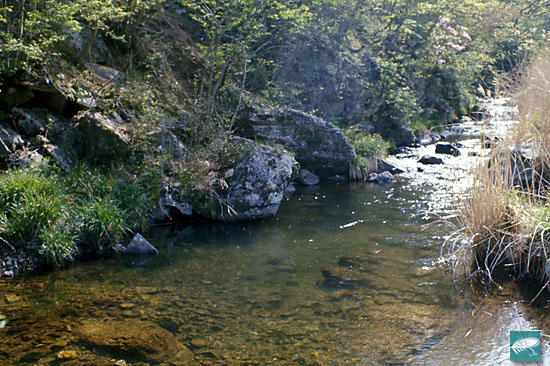
The upper reaches of the River Shishidome in early spring.
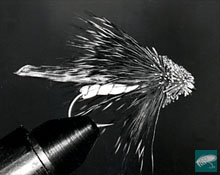
The early pattern of Muddler Sedge in 1973.
Most fish caught in the River Katsura were yamame trout and a few were rainbow trout which had been stocked. There was no shadow of brown trout so far. But I had a doubt. Even in Oshino, where a large number of brown trout and big rainbow trout had been caught, there was almost no catch during the day with dry fly. It is quite natural that many anglers believed that there was no big brown trout in Oshino because only a few small ones were caught with the dry fly in a year. I myself used the dry fly in the River Katsura. Isn’t it wrong to conclude that there is no brown trout or big trout in the River Katsura as far as the fishing method is different from Oshino?
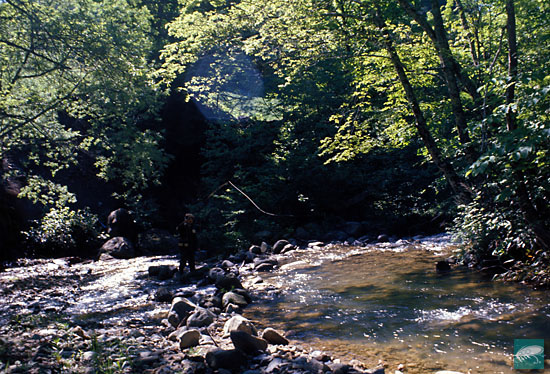
The River Shishidome in fresh green in May, 1976.
What will happen if I use Muddler Sedge in the River Katsura, downstream of Oshino? As I was fascinated by Oshino, I could not imagine that I fished other rivers in the evening, so precious hours. But now in the end of April when 2 months had passed since the opening day, I came back to Asumi in the evening for my experiment. I was ready for wasting the whole day.
The sunset became later in the end of April. It was as light as the daytime even at 6p.m. I parked near Asumi Bridge as usual and walked to the barrier just upstream with the rod. I was a little bit nervous because it was my first attempt to cast Muddler Sedge in a river except for Oshino. When I looked into the water, standing beside the barrier, a sedge flew away in front of me. Only a flying sedge made me expect a lot. I will be able to catch big fish here if the season is good enough! Probably successful fishing in Oshino gave me such a big hope.
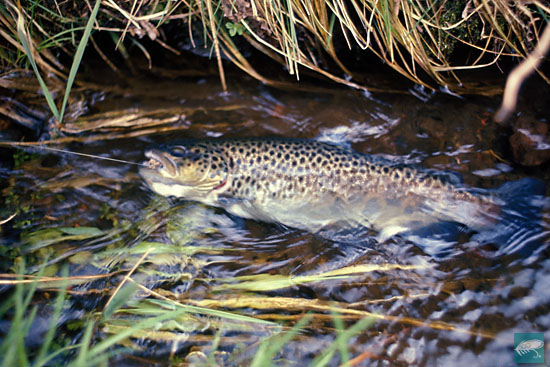
Brown trout stayed at the upper reaches of the River Katsura, too.
The side part of falling spot of the barrier was narrow but dug deeply. I cast Muddler Sedge into the whirling part under my feet. The fly drifted to the right and to the left, made a round on the dark surface and flowed to the pocket. I raised the rod in a flash and cast again. The fly settled on the centre of the whirling water and was drifting there in a little circle. Suddenly it became light behind the fly. At the next moment a fish rose from the bottom to the fly, twisting its body. It was the biggest one I had ever seen around there. Holding my breath, I watched it. It opened its big mouth near the surface, swallowed size 6 Muddler Sedge and slowly turned over.
When I came to my senses, the fish had sunk on the bottom, making my rod bent in a large arc. Every time it twisted its body my rod creaked. When it bit the fly and turned over, which was a momentary event although I felt as if it had taken ages, I thought it was not the way of yamame trout. It was not the pull of rainbow trout, either. Isn’t it a brown trout?
Soon the fish broke the surface. Big black spots were dotted on the beige body. No doubt a brown trout! I waited for the fish to be calm and grabbed the line. I was sure that 2x leader was strong enough. I retrieved the line very carefully and lifted the fish on the protected bank. It was a beautiful brown trout of 40cm. Its fins seemed bigger and its body a bit higher than those in the River Oshino.
-- To be continued --
- NET SHOP INFORMATION
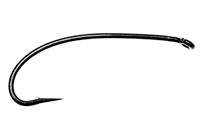
SL6 Black Spey Hooks
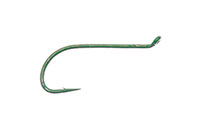
DU3 Limerick Spinner Hooks
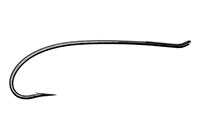
SL4 Single Bartleet Hooks
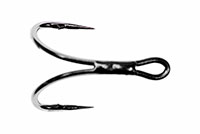
XD1 Tube Fly Double Hooks
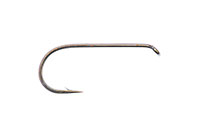
DD2 Flat Perfect Hooks
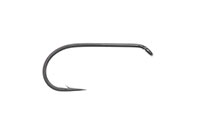
DD1 Black Terrestrial Hooks
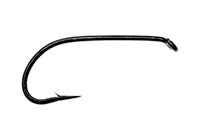
TD4 Old Limerick Wet Hooks
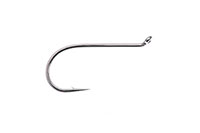
DU1 Silver May Hooks
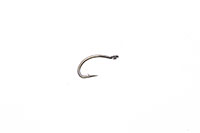
MU1 Flat Midge Hooks
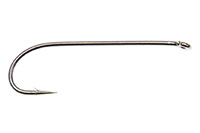
LD3 Long Limerick Hooks
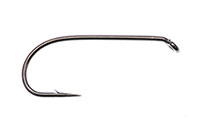
TD2 Summer Sproat Hooks
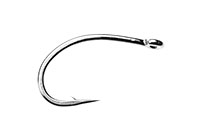
XS1 Tube Single Silver Hooks
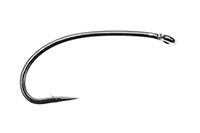
TD6 Siver Sedge Hooks

SL5 Black Spey Hooks

DU3 Limerick Spinner Hooks
- TROPHY CLUB
- FLY SHOW
- EXHIBITION
- MASTERS`
- FLY DRESSING CONTEST Archives
- TRAVELLER Archives
- TACKLE IMPRESSIONS Archives
- ANGLERS` PHOTO GALLERY Archives
- ----------------------------------------------
- トロフィークラブ
- フライショー
- エキシビション
- マスターズ
- フライドレッシング・コンテスト・アーカイヴ
- トラヴェラー・アーカイヴ
- タックル・インプレッション・アーカイヴ
- アングラーズ・フォトギャラリー・アーカイヴ
株式会社サワダ 185-0021 東京都国分寺市南町3-13-4
SAWADA'S INC. 3-13-4 Minamicho, Kokubunji, Tokyo 185-0021, Japan
写真・ドキュメントの無断転載を禁じます。
All the images and documents found on this site are owned by Ken Sawada and may not be used without permission.
But, link to this site is FREE.
Copyright © 2000 - 2024 SAWADA'S INC.. All rights reserved.
SAWADA'S INC. 3-13-4 Minamicho, Kokubunji, Tokyo 185-0021, Japan
写真・ドキュメントの無断転載を禁じます。
All the images and documents found on this site are owned by Ken Sawada and may not be used without permission.
But, link to this site is FREE.
Copyright © 2000 - 2024 SAWADA'S INC.. All rights reserved.
